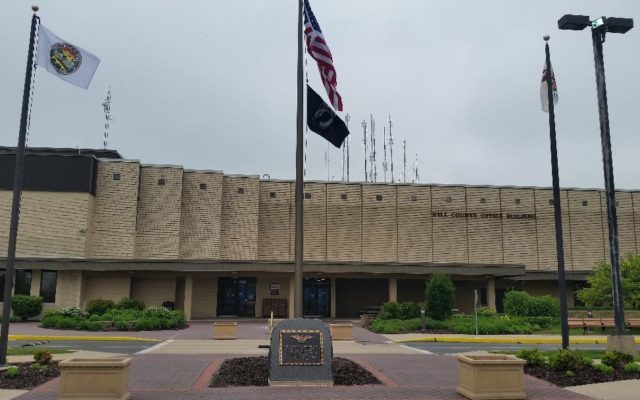Governor Says No Indoor Drinking or Dining for Will-Kankakee County Bars & Restaurants

Governor JB Pritzker and the Illinois Department of Public Health have announced new COVID-19 mitigation efforts will be implemented in Region 7, the greater Will and Kankakee County areas, beginning Wednesday, August 26 after the region reached 8 percent positivity for three days. Region 7, mitigation measures taking effect August 26, 2020 include the following:
Bars
No indoor service
All outside bar service closes at 11:00pm
All bar patrons should be seated at tables outside
No ordering, seating, or congregating at bar (bar stools should be removed)
Tables should be 6 feet apart
No standing or congregating indoors or outdoors while waiting for a table or exiting
No dancing or standing indoors
Reservations required for each party
No seating of multiple parties at one table
Restaurants
No indoor dining or bar service
All outdoor dining closes at 11:00pm
Outside dining tables should be 6 feet apart
No standing or congregating indoors or outdoors while waiting for a table or exiting
Reservations required for each party
No seating of multiple parties at one table
Meetings, Social Events, Gatherings
Limit to lesser of 25 guests or 25% of overall room capacity
No party buses
Gaming and Casinos close at 11:00pm, are limited to 25 percent capacity, and follow mitigations for bars and restaurants, if applicable
These mitigations do not currently apply to schools and the measures will remain in effect over a 14-day period after which time more stringent mitigation measures can be implemented if metrics do not improve. The Illinois Department of Public Health will continue to monitor each region in the state for several key indicators to identify early, but significant increases of COVID-19 transmission in Illinois, potentially signifying resurgence. Indictors include an increase in COVID-19 cases with a simultaneous decrease in hospital capacity, or three consecutive days greater than or equal to 8% test positivity rate (7 day rolling). These indicators can be used to determine whether additional community mitigation interventions are needed for a region to prevent the further spread of COVID-19.
IDPH will track the positivity rate in both regions to determine if mitigations can be relaxed, if additional mitigations are required, or if current mitigations should remain in place. If the positivity rate averages less than or equal to 6.5 percent over a 14-day period, then Regions 4 and 7 will return to Phase 4 mitigations under the Restore Illinois Plan. If the positivity rate averages between 6.5 percent and 8 percent, the new mitigations will remain in place and unchanged. If the positivity rate averages greater than or equal to 8 percent after 14 days, more stringent mitigations will be applied to further reduce spread of the virus. (1340 WJOL-News)
Here’a review of the difference between Phase 3 and Phase 4 according to the Illinois Department of Health:
Phase 3 – Recovery: The rate of infection among those surveillance tested, the number of patients admitted to the
hospital, and the number of patients needing ICU beds is stable or declining. Manufacturing, offices, retail,
barbershops and salons can reopen to the public with capacity and other limits and safety precautions. Gatherings
limited to 10 people or fewer are allowed. Face coverings and social distancing are the norm.
Phase 4 – Revitalization: The rate of infection among those surveillance tested and the number of patients admitted
to the hospital continues to decline. Gatherings of 50 people or fewer are allowed, restaurants and bars reopen, travel
resumes, child care and schools reopen under guidance from the Illinois Department of Public Health. Face coverings
and social distancing are the norm.
Phase 5 – Illinois Restored: With a vaccine or highly effective treatment widely available or the elimination of any
new cases over a sustained period, the economy fully reopens with safety precautions continuing. Conventions,
festivals and large events are permitted, and all businesses, schools and places of recreation can open with new
safety guidance and procedures in place reflecting the lessons learned during the COVID-19 pandemic.
Until COVID-19 is defeated, this plan also recognizes that just as health metrics will tell us it is safe to move forward,
health metrics may also tell us to return to a prior phase. With a vaccine or highly effective treatment not yet
available, IDPH will be closely monitoring key metrics to immediately identify trends in cases and hospitalizations to
determine whether a return to a prior phase may become necessary
WHAT PHASE 3 LOOKS LIKE
The rate of infection among those surveillance tested is stable or declining. COVID-19-related hospitalizations and
ICU capacity remains stable or is decreasing. Face coverings in public continue to be required. Gatherings of 10
people or fewer for any reason can resume. Select industries can begin returning to workplaces with social
distancing and sanitization practices in place. Retail establishments reopen with limited capacity, and select
categories of personal care establishments can also begin to reopen with social distancing guidelines and personal
protective equipment. Robust testing is available along with contact tracing to limit spread and closely monitor the
trend of new cases.
WHAT’S OPEN
Gatherings: All gatherings of 10 people or fewer are allowed with this limit subject to change based on latest data & guidance
Travel: Travel should follow IDPH and CDC approved guidance
Health Care: All health care providers are open with DPH approved safety guidance
Education and child care: Remote learning in P-12 schools and higher education; Limited child care and summer
programs open with IDPH approved safety guidance
Outdoor recreation: State parks open; Activities permitted in groups of 10 or fewer with social distancing
Businesses:
• Manufacturing: Non-essential manufacturing that can safely operate with social distancing can reopen with
IDPH approved safety guidance
• “Non-essential” businesses: Employees of “non-essential” businesses are allowed to return to work with
IDPH approved safety guidance depending upon risk level, tele-work strongly encouraged wherever possible;
Employers are encouraged to provide accommodations for COVID-19-vulnerable employees
• Bars and restaurants: Open for delivery, pickup, and drive through only
• Personal care services and health clubs: Barbershops and salons open with IDPH approved safety guidance; Health
and fitness clubs can provide outdoor classes and one-on-one personal training with IDPH approved safety guidance
• Retail: Open with capacity limits and IDPH approved safety guidance, including face coverings
HOW WE MOVE TO THE NEXT PHASE
Cases and Capacity: The determination of moving from Phase 3 to Phase 4 will be driven by the COVID-19 positivity
rate in each region and measures of maintaining regional hospital surge capacity. This data will be tracked from the
time a region enters Phase 3, onwards.
• At or under a 20 percent positivity rate and increasing no more than 10 percentage points over a 14-day period, AND
• No overall increase (i.e. stability or decrease) in hospital admissions for COVID-19-like illness for 28 days, AND
• Available surge capacity of at least 14 percent of ICU beds, medical and surgical beds, and ventilators
Testing: Testing available in region regardless of symptoms or risk factors
Tracing: Begin contact tracing and monitoring within 24 hours of diagnosis for more than 90% of cases in region
WHAT COULD CAUSE US TO MOVE BACK
IDPH will closely monitor data and receive on-the-ground feedback from local health departments and regional
healthcare councils and will recommend moving back to the previous phase based on the following factors:
• Sustained rise in positivity rate
• Sustained increase in hospital admissions for COVID-19 like illness
• Reduction in hospital capacity threatening surge capabilities
• Significant outbreak in the region that threatens the health of the region
WHAT PHASE 4 LOOKS LIKE
There is a continued decline in the rate of infection in new COVID-19 cases. Hospitals have capacity and can quickly
adapt for a surge of new cases in their communities. Additional measures can be carefully lifted allowing for schools
and child care programs to reopen with social distancing policies in place. Restaurants can open with limited
capacity and following strict public health procedures, including personal protective equipment for employees.
Gatherings with 50 people or fewer will be permitted. Testing is widely available, and tracing is commonplace.
WHAT’S OPEN
Gatherings: Gatherings of 50 people or fewer are allowed with this limit subject to change based on latest data and
guidance
Travel: Travel should follow IDPH and CDC approved guidance
Health care: All health care providers are open
Education and child care: P-12 schools, higher education, all summer programs, and child care open with IDPH
approved safety guidance
Outdoor Recreation: All outdoor recreation allowed
Businesses:
• Manufacturing: All manufacturing open with IDPH approved safety guidance
• “Non-essential” businesses: All employees return to work with IDPH approved safety guidance; Employers
are encouraged to provide accommodations for COVID-19-vulnerable employees
• Bars and restaurants: Open with capacity limits and IDPH approved safety guidance
• Personal care services and health clubs: All barbershops, salons, spas and health and fitness clubs open
with capacity limits and IDPH approved safety guidance
• Entertainment: Cinema and theaters open with capacity limits and IDPH approved safety guidance
• Retail: Open with capacity limits and IDPH approved safety guidance
HOW WE MOVE TO THE NEXT PHASE
Post-pandemic: Vaccine, effective and widely available treatment, or the elimination of new cases over a sustained
period of time through herd immunity or other factors.
WHAT COULD CAUSE US TO MOVE BACK
IDPH will closely monitor data and receive on-the-ground feedback from local health departments and regional
healthcare councils and will recommend moving back to the previous phase based on the following factors:
• Sustained rise in positivity rate
• Sustained increase in hospital admissions for COVID-19 like illness
• Reduction in hospital capacity threatening surge capabilities
• Significant outbreak in the region that threatens the health of the region
WHAT PHASE 5 LOOKS LIKE
Testing, tracing and treatment are widely available throughout the state. Either a vaccine is developed to prevent
additional spread of COVID-19, a treatment option is readily available that ensures health care capacity is no longer a concern, or there are no new cases over a sustained period. All sectors of the economy reopen with new health and
hygiene practices permanently in place. Large gatherings of all sizes can resume. Public health experts focus on
lessons learned and building out the public health infrastructure needed to meet and overcome future challenges.
Heath care equity is made a priority to improve health outcomes and ensure vulnerable communities receive the
quality care they deserve.
WHAT’S OPEN
• All sectors of the economy reopen with businesses, schools, and recreation resuming normal operations with
new safety guidance and procedures.
• Conventions, festivals, and large events can take place.






